A walk around the Stolpersteine of Milan by David Roberts
On 23 January, they placed some more Stolpersteine or pietri d'inciampi ( stumbling stones) in the city of Milan. A further placing will happen, I believe in March which will bring the total number of Stolpersteine to 171. I had already photographed many of them at differing times. The photos are in the gallery on this site. Stolpersteine Part 1. Stolpersteine Part 2 and Stolpersteine Part 3.I published a blog back in 2021 of some of the earlier ones. Due to the various lockdowns, I had not recorded a number of the 2021 and 2022 placings. so being a pleasant winter afternoon, I went out for a long walk in Milan to capture some more.
This walk started at the Piola metro station and covers the area around the Citta Studi, Politecnico, ,and down the long viale Romagna/ Campania and back up to Loreto. . These are the stolperstein, I saw in one single four-hour walk. I have previously seen some others in the same area , which I will incorporate in a more comprehensive guide, with some better directions,
While, I work on something more comprehensive, he following will help in understanding below and avoiding repetition In 1938, Fascist Italy passed a series of Racial Laws , which similar to the German Nuremberg Laws excluded Jewish Italians from schools, universities and many professions, and provided for the deportation or exclusion of foreign-born Jews. In a typically Italian fudge, Jewish Italian were able to seek an exemption from the laws if they met various qualifications. The Italians also conducted a census of the Jewish population, which later fell into the hands of the Germans. Despite the Racial Laws, many of Italy’s highly assimilated Jewish population stayed put, hoping things would get better. In June 1940, Italy declared war on Britain and France, and after three years of largely unsuccessful fighting , in June 1943 Allied Forces landed in Sicily. Mussolini was overthrown and the Italians signed an Armistice with the Allies on 8 September 1943. The Germans invaded Italy and in October 1943, re-established a somewhat reluctant Mussolini as Head of the Repubblicca Sociale Italiana , ( RSI) based in the North of the country. The Germans occupied Milan and turned their attention to the city’s Jewish population. As they were rounded up Milan’s Jewish population were taken to the notorious San Vittore prison and then either to the transit camp at Fossoli di Carpi or sent direct to Milan’s Centrale Station, where transport to concentration camps were organised at the secret underground platform Binario 21.

The underground platform - Binario 21 at Milan Central station from where the deportations began
As the Allies moved up the peninsula, the camp at Fossoli was abandoned and a transit camp established further north at Bolzano. Most of the Jewish prisoners went straight to Auschwitz.
As can be seen from the following stories, not all the deportations were of Jewish Italians, a huge number of anti-Fascist activists and partisans were also deported, In March 1944, there was a General Strike which covered most of Milan’s major industrial concerns, Pirelli, Breda and Caproni. Huge numbers of strikers were detained after 1 March 1944 and sent to San Vittore, from there to Bergamo and on transports to Mauthausen in Austria and its numerous sub. Camps, where they were literally worked to death or died of starvation and neglect. If you want some more of the rather grim history of resistance and repression in Milan, you might read this article first for some context.
The Stolpersteine are placed outside the places where the deportees are known to have lived or worked. In August 1943, Milan was subject to intense allied bombing with large parts of its housing stock destroyed, ( not to mention its artistic and cultural patrimony) In some cases, the Stolpersteine are outside new buildings which replaced those destroyed by bombing. To some extent it depends on the area. In most cases, the Stolpersteine below are outside the original buildings. The first Stolpersteine were placed in Milan in 2016 and annual placings have followed ever since. Following the new placings in 2023 , there will be 171 in total. They are spread all over the city, so this is just a sample in one specific area.
Certainly, this tour avoids the city centre, and you will not see any of Milan’s architectural treasures or its high-end fashion stores on the way. You will see a lot of pre-war apartment blocks and villas, some more preserved than others and it is distinctly off the beaten track, although the route passes numerous bars and cafes, for refreshment and comfort breaks. Some of the areas appear a little neglected ( especially away from the main roads) , although should be safe enough by day.
On a bright sunny day, with streets alive with people and traffic, it is difficult to picture that these same streets were once full of fear. Fear of informers; fear of the sudden arrival of the SS or Fascist militia; fear of neighbours; fear of the Nacht und nebel . Although some of the people below had moved away from the Milan when they were detained. Sone of the doorways you see, were the last things that people would have been seen before being transported into the nightmare world of the Third Reich.
Dante Spallanzani Viale Lombardia, 11
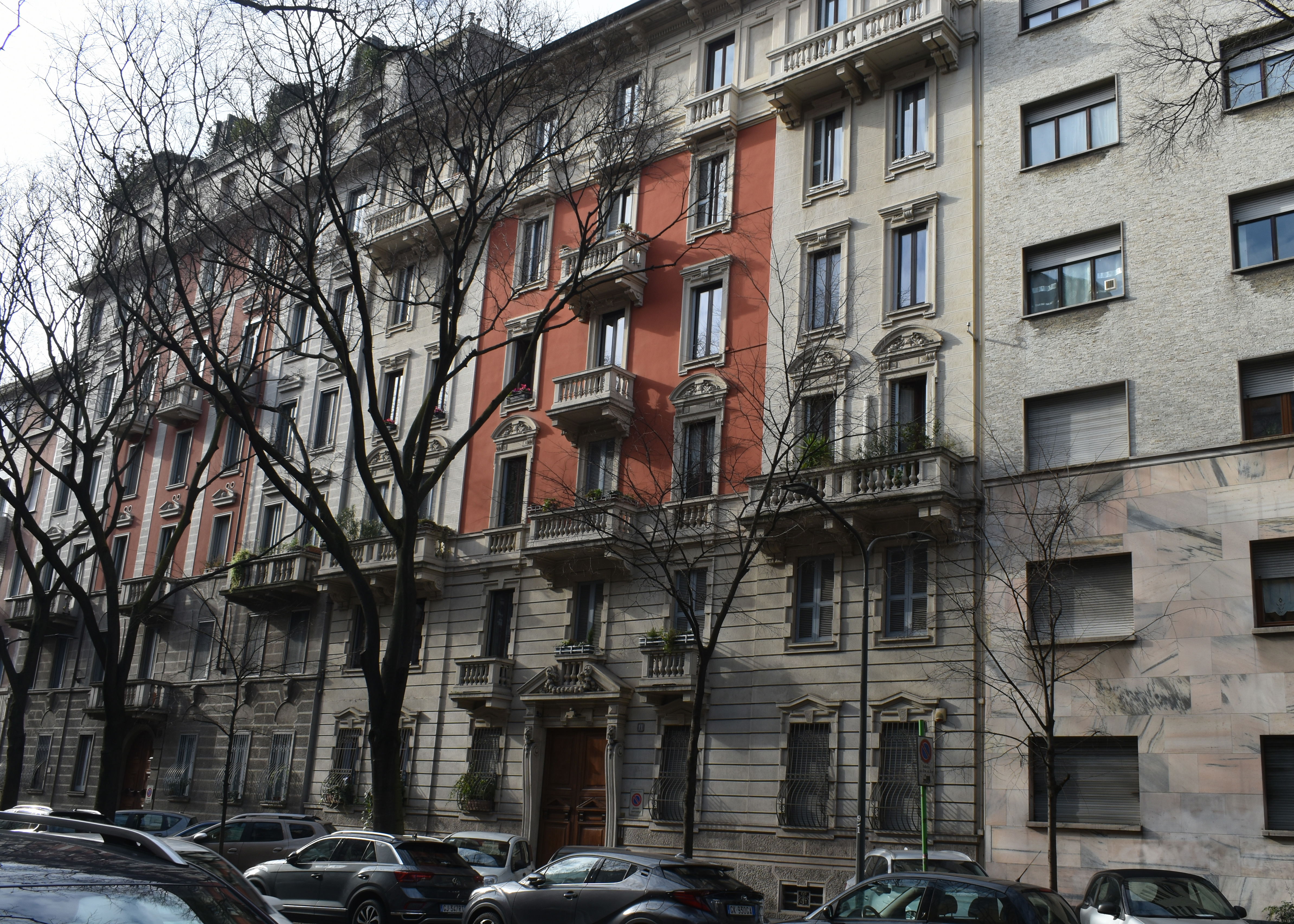
Viale Lombardia, 11
Coming out of Piola Metro Station, you head towards piazza Gabrio Piola and head up viale Lombardia which is at12 noon on the circular piazza, about five minutes up the road at viale Lombardia 11 , you will find the Stolperstein commemorating Dante Spallazani. Dante was an employee of the aircraft manufacture Caproni in Taliedo ( some of the old buildings of which still exist near Linate Airport) , He lived there with his wife Bianca, niece Lilliana and brother Gino. He had been a young socialist and committed himself to the SAP at Taliedo. After the strike on 1st March 1944, the personnel director of Caproni gave a list of supposed agitators to the authorities, Dante was one of those detained. He was arrested on 11 March, and made the journey to the Questura ( Police HQ ) a in piazza San Fedele, San Vittore prison , and then to Caserma Umberto I in Bergamo, and from Bergamo Railway Station to Mauthausen, where he arrived on 20 March 1944..Made ill by the terrible conditions, he was sent to the “hospital” at the camp in Melk , where on 31 January 1945, he was murdered by an injection of petrol.
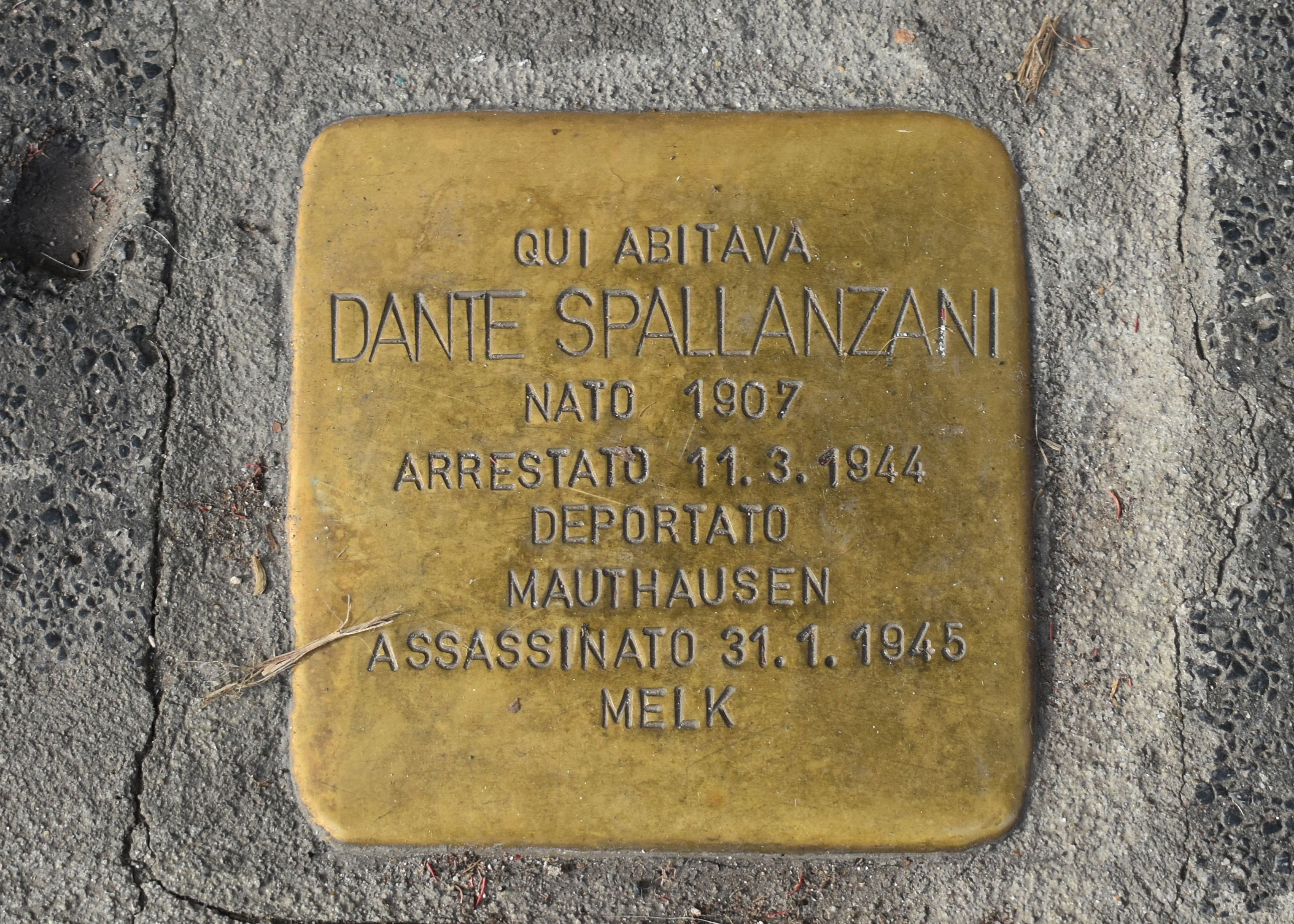
Mario Luperini, via Giuseppe Colombo 64
Heading back across piazza Pola , we now exit on the roads which is about 20 past the hour and head towards the piazza Leonardo Da Vinci and the Politecnico, passing by the whole front of the main building.
Away from the main buildings you have to find the rather nondescript side street of via Giuseppe Colombo. Outside a derelict old building, (,Via Giuseppe Colombo , 64) you find the Stolperstein for Mario Luperini. There is also an earlier commemoration placed on the wall

Via Giuseppe Colombo, 64
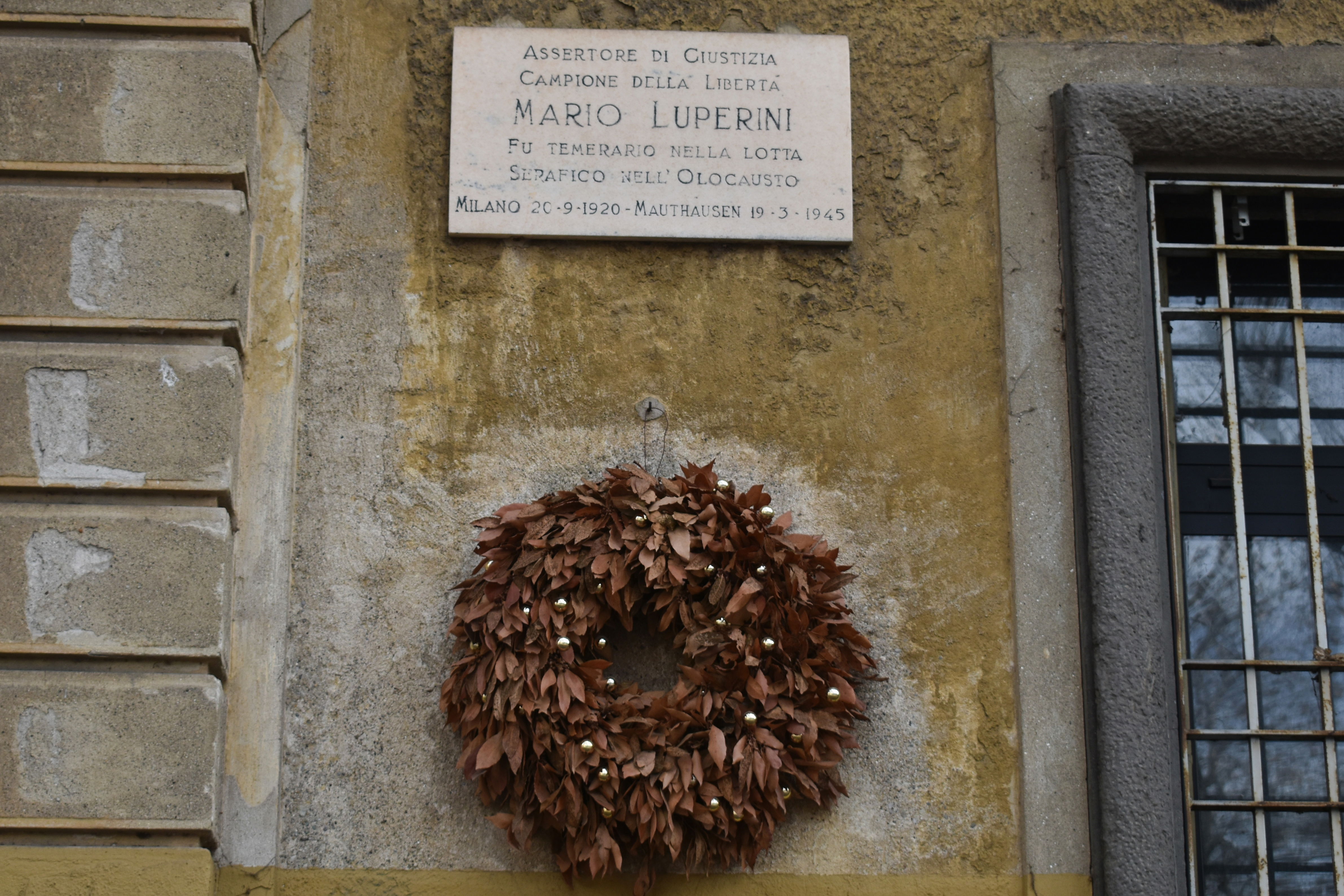
Memorial plaque for Mario Luperini
Mario Luperini ( Milano,20 September 1920) graduated from High school in ragioneria and was studying at the Politecnico. The Politecnico was one of the centres of anti-fascist resistance and site of numerous round ups. Mario was arrested on 16 March 1944, imprisoned in San Vittore, deported to Fossoli, and from there to Bolzano and to Mauthausen, with Transport 73, he was transferred toi the terrible subcamp at Gusen, and then sent to the hospital camp” at Mauthausen where he died on 15 March 1945.

Aquillino Mandelli- via Vigilio Inama 24
From via Giuseppe Colombo, it is about 10 minutes’ walk to the residential street of via Vigilio Inama. At number 24, in a old apartment block next to a supermarket, you find the Stolperstein for Aquillino Mandelli.

Via Vigilio Inama
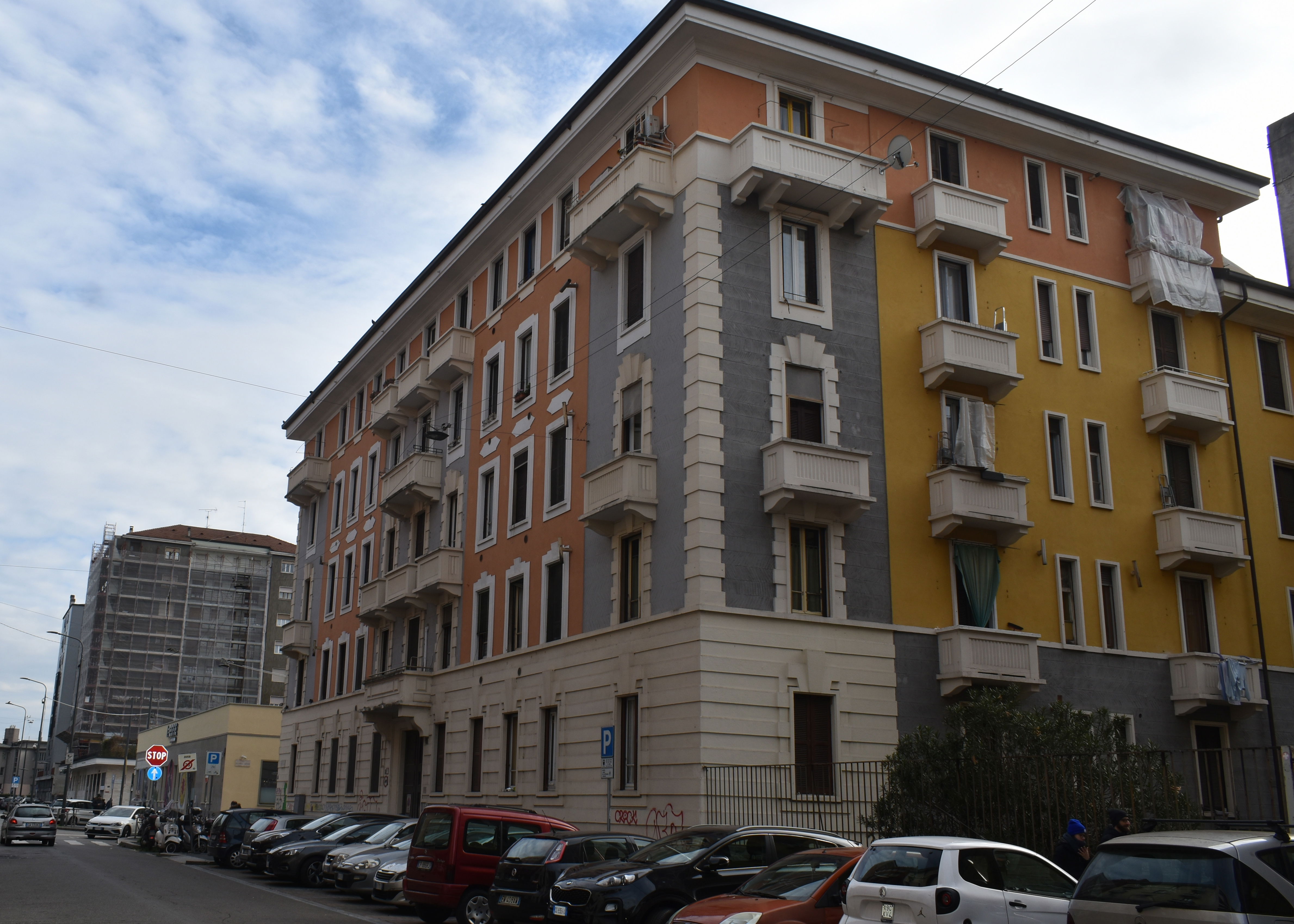
The apartment block at via Vigilio Inama, 24 where Aquillino Mandelli lived.
Aquillino Mandelli ( Milano , 23 September 1908 ) Aquillino worked as a mechanic at Caproni. In 1933 he married Virginia Oddone and they had one son , Giorgio. Aquillino was already a known anti-fascist and in 1936 he was entered in the Casellario Politico Centrale ( CPC) to be considered for detention for circulating anti-Fascist propaganda inside the factory. On 18 October 1943 he was arrested and imprisoned at San Vittore . He managed to get some letters out of the prison to Virginia. He was put on Transport 25 and arrived at Mauthausen on 21 February 1944, from there he was transferred to Schwechat-Floridsdorf and in 16 February 1945 to the notorious sub-camp at Gusen, where he died on 8 March 1945.
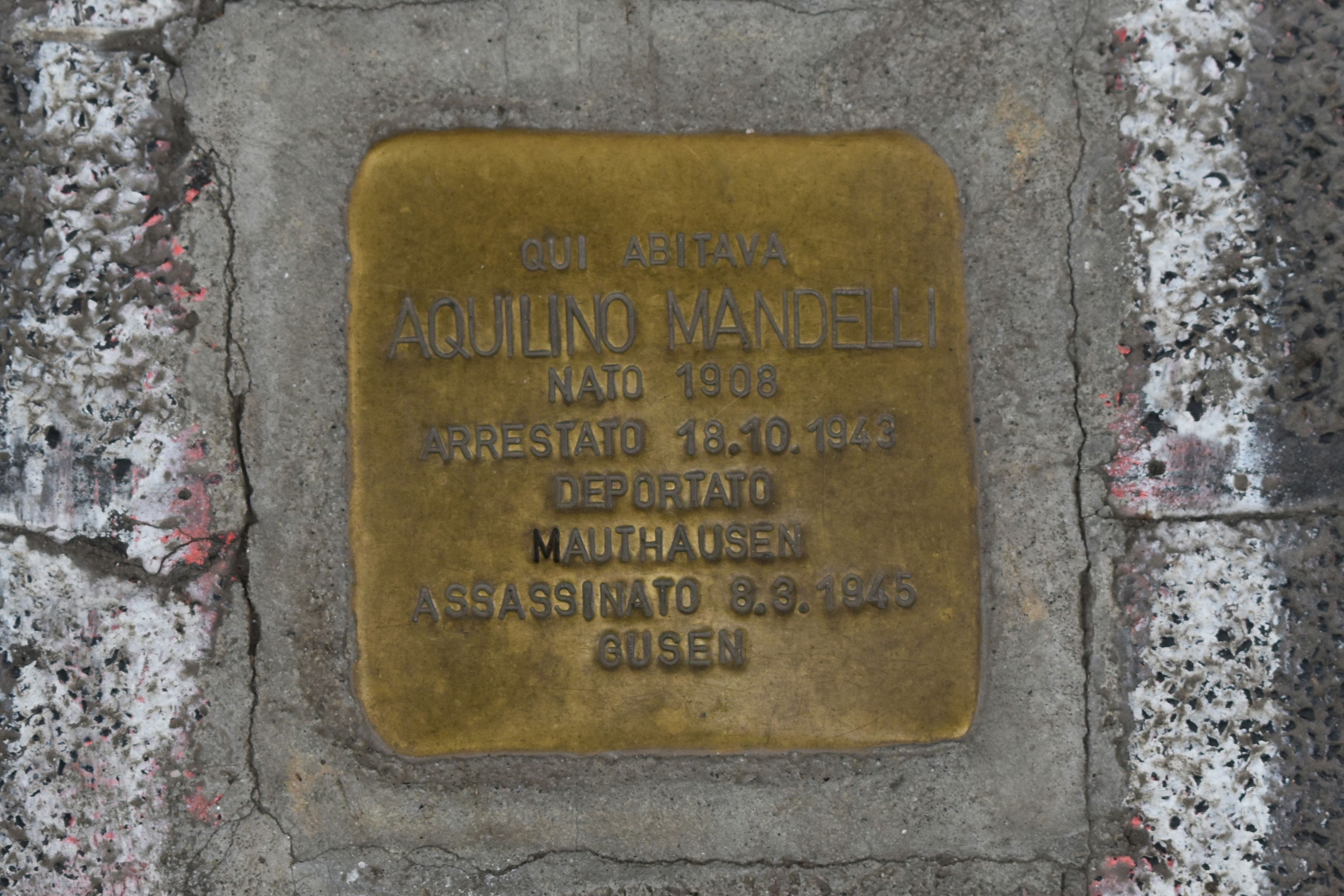
After Aquillino, you need to get back to the long main road ( viale Romagna .) for a further twenty minute walk towards Corso 22 Marzo, Here in Via Mario Giurati a short residential street, off the left hand side there are three Stolpersteine in the same road.
Via Mario Giurati
Francesco Moschettini, Via Mario Giurati,17


Via Mario Giurati

Francesco Moschettini's house at via Mario Giurati 17
Francesco Moschettini ( Ginosa (TA), 21 November 1914). Francesco graduated in electronical engineering from the Politecnico di Milano, and enlisted in the Navy . After ’8 September 1943, he joined the Fire Brigade of Milan and also the Resistance. Francesco was involved with a clandestine radio transmitter and telephone exchange , which had been installed underground at the Politecnico and which was used to supply information to CLN Alta Italia. Betrayed by a tout, Francesco was arrested on 21 September 1944., and deported to Bolzano and on 20 November 1944 to Mauthausen. He died at a Gusen on 24 January 1945.

Raffaello Giolli, via Mario Giurati 16
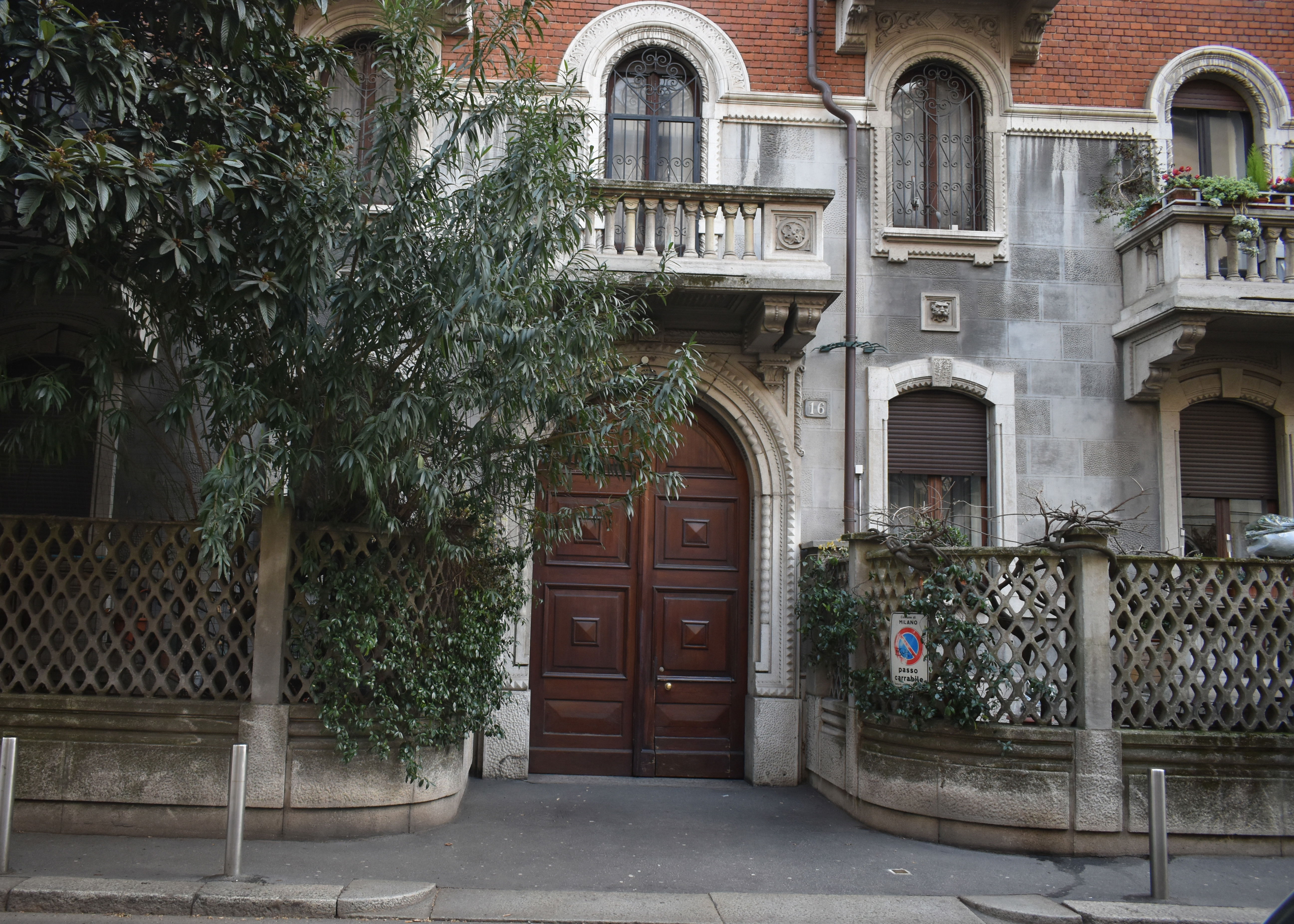
Raffaello Giolli's house at via Mario Giurati, 16
Across the road, is the Stolperstein for Raffaello Giolli ( Alessandria , April 1889) . Raffaello studied at grammar schools in Milan and Novara. Passionately interested in Art History, he enrolled at the Universities of Pisa and Bologna. Thereafter, he dedicated his life to art and the history of art, writing for numerous journals on the subject. In 1920 he married Rosa Menni and they had three children; Paolo, Federico and Ferdinando. From 1925 onwards, Raffaello taught art history , at the Accademia libera di cultura e arte , and also at the state grammar schools, Berchet, Parini, and Beccaria, until he was dismissed for refusing to join the Fascist Party. In July 1940, he was arrested by the OVRA ( the secret police) and interned with his son Paolo in Abruzzi. On his return to Milan, he continued to write for numerous journals., and under the name “Giusto” for underground journals. In September 1944 he was arrested with his wife and Federico, by Fascist Militia from the legione Muti, he was tortured by them and transferred to San Vittore and then Mauthausen. He died at Gusen 2 between 5 and 6 January 1945

Aurelia Allegra Levi Finzi and Emma Laura Finzi, Via Mario Giurati ,5
Further down Via Giurati at number 5 are two stolpersteine together commemorating Aurelia Allegra Levi Finzi and Emma Laura Finzi.

via Mario Giurati, 5
Aurelia Allegra Levi Finzi ( Vercelli, 24 September 1874.), married Leone Finzi and had two children with him , Giulio (1903) and Emma (1905). Leone Finzi an industrialist enrolled with the PNF since November 1922, died in a traffic accident in the mid-1930s. Giulio moved to London, when he understood that things were going to get bad for Jewish Italians, he managed to get visas and tickets for his mother and sister. Aurelia refused to leave, believing that nothing would happen to them as Italian citizens. Emma Laura worked as artist, particularly on silks and glass she also held art lessons Aurelia and Emma were captured on 25 October 1943 when, too late they tried to cross the Swiss border. They were imprisoned in Como, then San Vittore until they were deported on 6 December 1943 on the first Transport ( no,. 20) to leave Milan direct for Auschwitz. Aurelia was murdered on arrival at Auschwitz-Birkenau on ’11 December 1943. Emma Laura died at Birkenau, exact date and place unknown.

Samuel Emilio Fiorentino
via Giuseppe Piolti de' Bianchi, 18
At the end of via Giurati , turn right head up to the next junction and turn left, about a hundred yards further take a right hand turn onto via Piolti de' Bianchi and we find the next Stolperstein. Samuel Emilio Fiorentino (Livorno , 20 April 1872 ) He was the cousin of Iginia Fiorentino n( see below) . In 1900 he married Giulietta Formiggini: in 1902 they had a son , Angiolo Bismark, who was physically disabled. Samuel was a bookkeeper by profession and the family established themselves in Milan in Via Piolti de’ Bianchi 18.
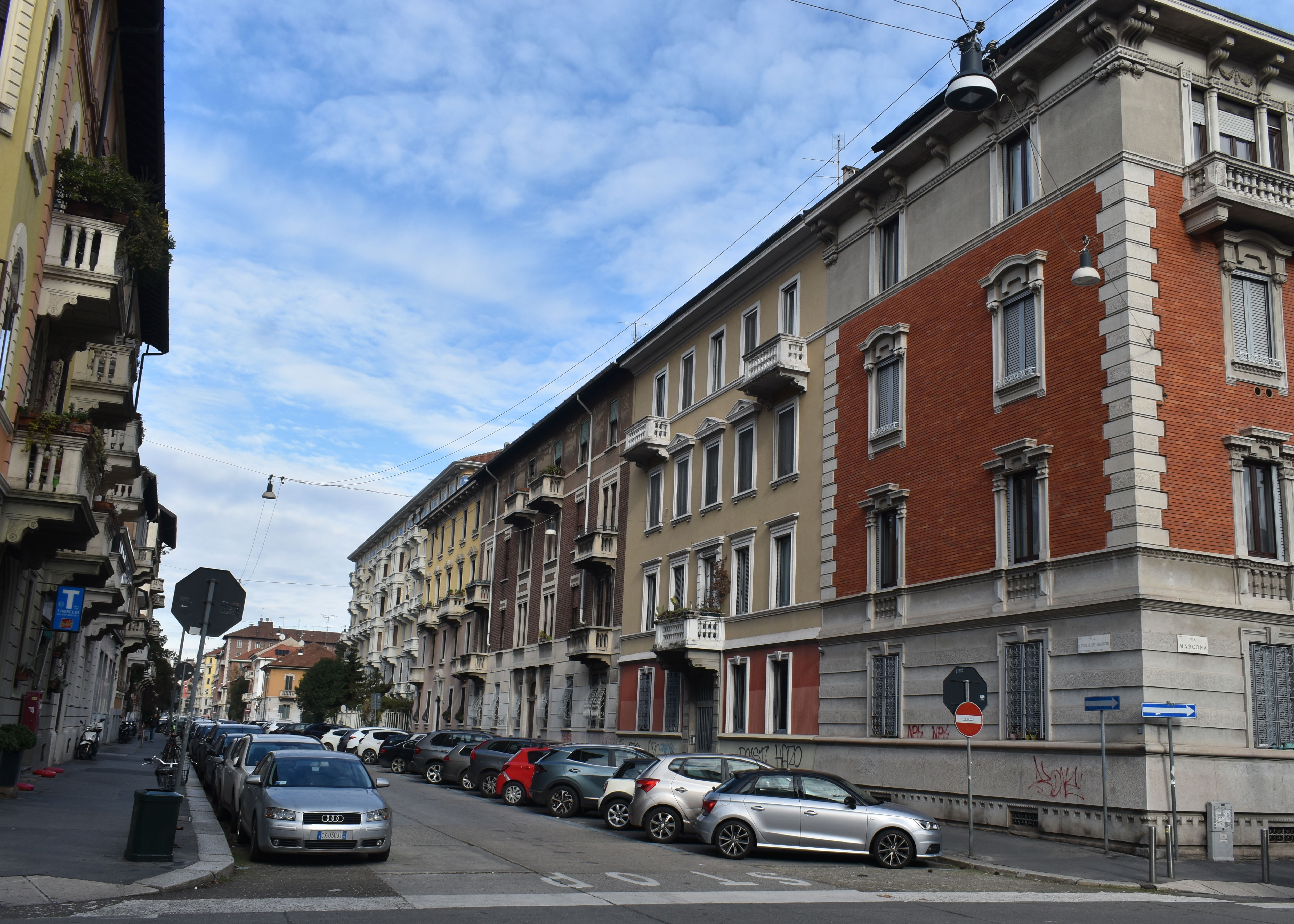
via Piolti de' Bianchi
After the racial laws of 1938 they moved to the frontier town of Porto Ceresio in Via Selva Piana 15, where they owned a villa. From Porto Ceresio you can see the Swiss border, but they were obviously unable to get across, it was not possible to walk through the frontier along the road and possibly Angiolo’s disabilities made it difficult to cross through the mountains.
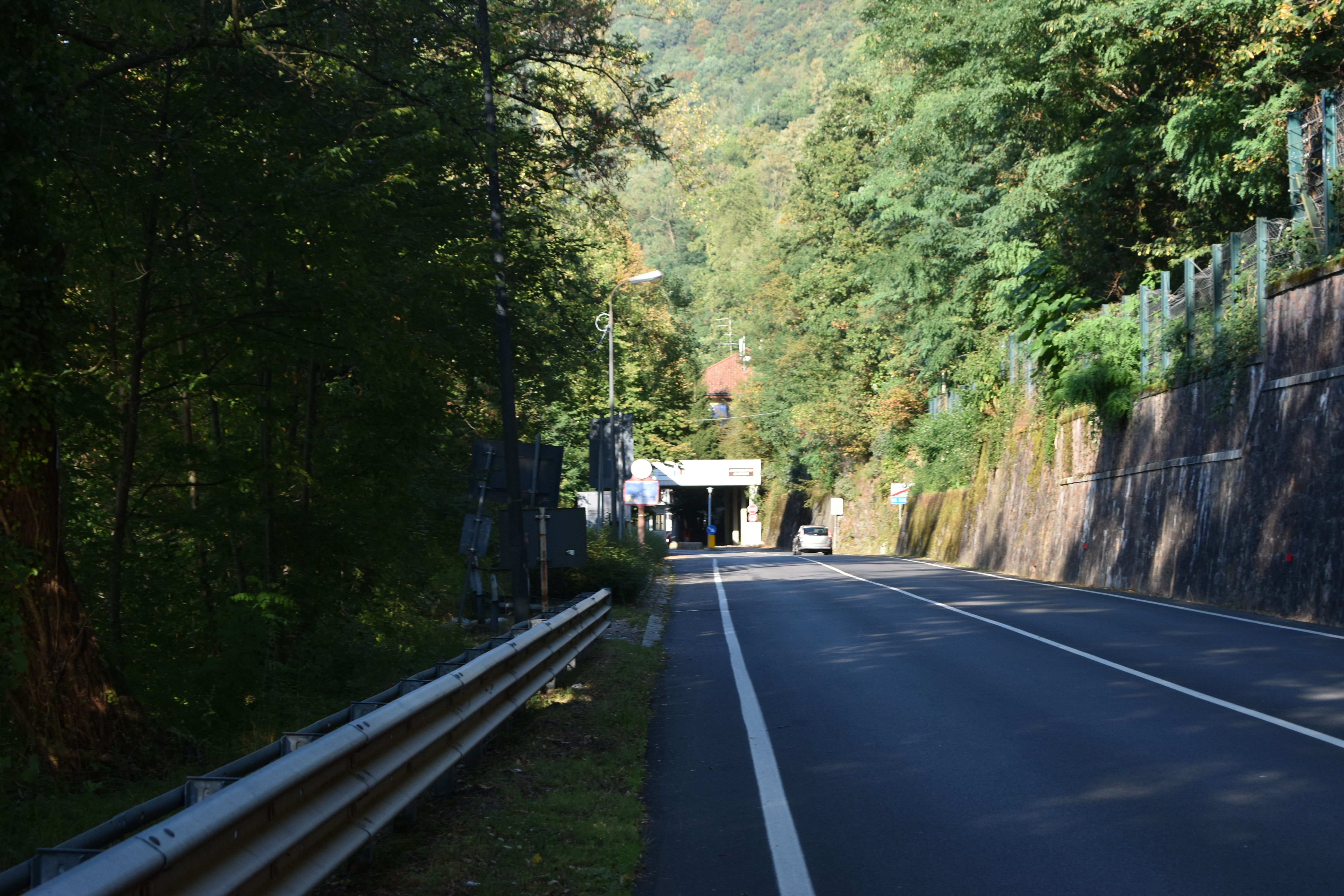
The Swiss border at Porto Ceresio- the Fiorentino family never managed to get across.
After 8 September, things got worse. The villa was confiscated and on 29 January 1944, Samuel gave himself up to the Germans, certainly with the intention of saving his wife and son. He was detained in Varese prison, then sent to San Vittore , from there he was put on Transport 24 on 30 January 1944 for Auschwitz. He was murdered on arrival.

Memorial at Binario 21
Thanks to his sacrifice, his wife and son survived , their apartment in Milan and villa in Porto Ceresio were restored to them, they retired to live in Florence at the Casa di Riposo Ebraica.

Leaving via Piolti de Bianchi and turning right, you come straight out onto the main road. Here you have a choice, you can go on a bit further across Corso 22 marzo , for two more Stolpersteine, or you can turn back and head up the viale Campania towards Loreto.
South of Corso 22 Marzo ( optional)
Crossing the Corso and walking on the same side of the road as the park. After about 10 minutes, you get to a right hand turn for via Perugino.
Luigi Pietro Cappelletti, Via Perugino 15


via Perugino, 15
Luigi Pietro Cappelletti ( Guanzate (CO), 22 April 1894), married Annunziata Cappelletti and they had two children Annamaria (1927) and Ercole (1935). Luigi Pietro worked at Breda as a mechanic, Annunziata, worked from home as a tailor. On 12 March 1944, following the 1° March 1944 strike in which he had participated, he was detained at home in the dead of night and made the trip to San Vittore and Bergamo for Transport 34 to Mauthausen, he was, transferred to the camp at Gusen where he died on 8 April 1944.

Go back the way you came to the main road , turn right and head south for another 100 minutes, cross the road and you find the entrance to via Strigelli. When I was there the Stolperstein for Bruno Valbrega has not yet been laid, it should be later in 2023. But I looked at the house anyway.
Bruno Valbrega, via Strigelli

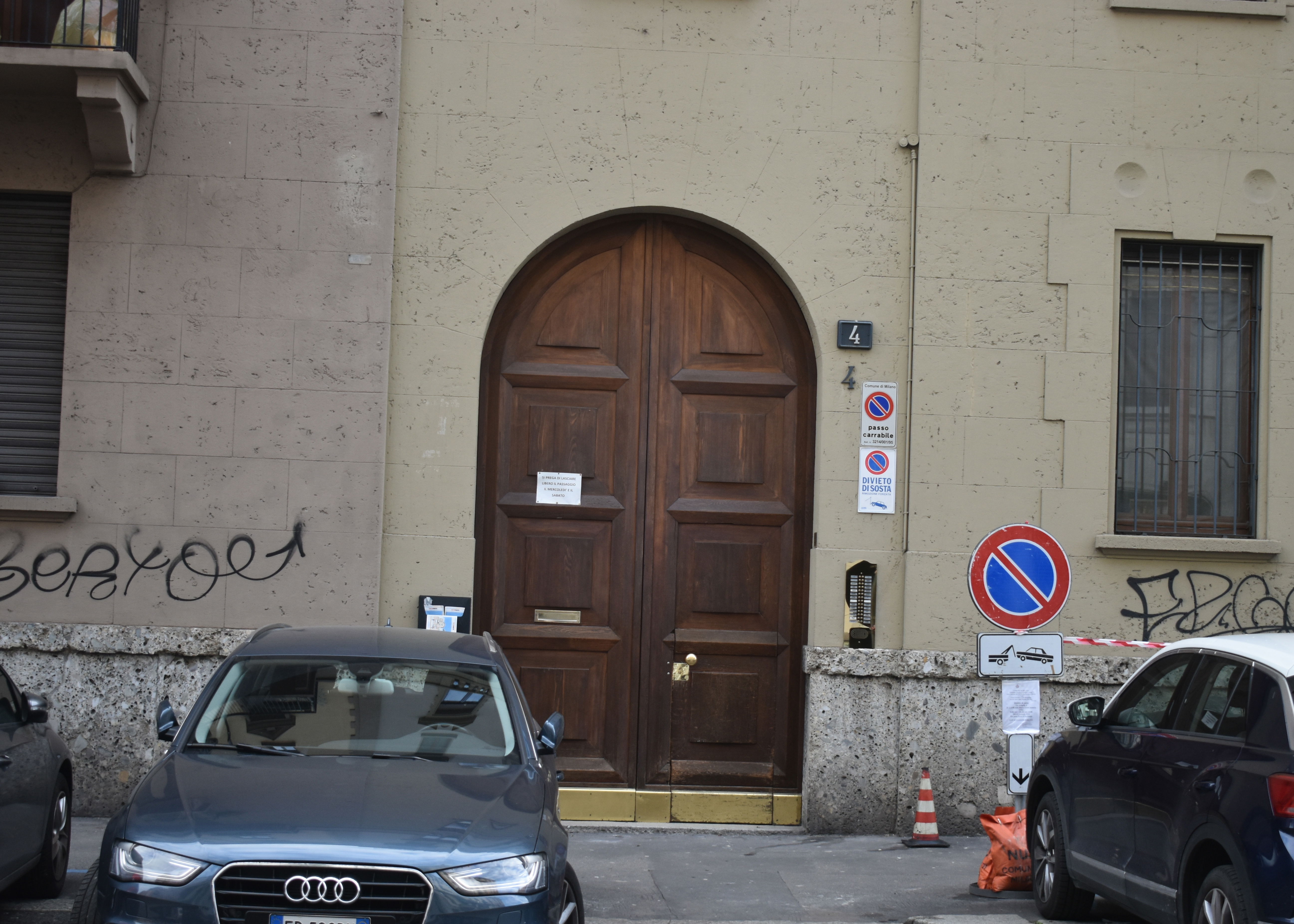
Bruno Valabrega (Milano 3 October 1907 ), Bruno gained his diploma from the liceo Manzoni and went on to graduate in electronic engineering . In August 1930, he married Rosa Balduini (Bari, 27/10/1910) and they moved to via Strigelli 4. They has five children : Walchiria, Sigfrido, Oscar, Sergio e Alda. Bruno worked as design engineer at CGE (Compagnia Generale di Elettricità S.p.A); in his free time he painted and played the violin. Following the passing of the Racial Laws, he was forced to change jobs almost annually . Finally aat ther end of June he was tipped off that he was about to e arrested and went on the run, The Germans arrested hid family and took then to San Vittore, in order to prevent them being deported he gave himself up on 17 July. He was transferred to Fossoli and from there to Auschwitz (Transport n.72), where he arrived on 6 August On 27 October 1944 he was transferred to Dachau (n.119758) where he died at the sub-camp of Kaufering, on 28 January1945.
Michele Tarantino, via degli Etruschi, 2
The next Stolperstein here is a bit of a hike, through a couple of less than interesting estates. There appears to be no original building here and the stolperstein is outside a modern looking block. Probably the block on the other side reflects wjhat iit used to look like. The area is not so prepossessing, but it is worth paying tribute to Michele Tarantino.

Via degli Etruschi, 2 - rather forlorn with the Stolperstein rather difficult to find
Michele Tarantino ( Caltanissetta 12 May 1896), Married Giuseppa Giardina and the couple had four children, Maria (1930), Maria Luisa (1933), Anna (1935), Renato Matteo (1941). In 1941 la the family moved to Via degli Etruschi 2. Michele was a driver working for the Comune di Milano, from a depot in Via Pompeo Leoni. There he became involved in anti-Fascist activities. He was arrested on 26 October 1944 and sent to San Vittore from where he was deported to Mauthausen on Transport 104: he was transferred to Gusen where he died on 4 February 1945.
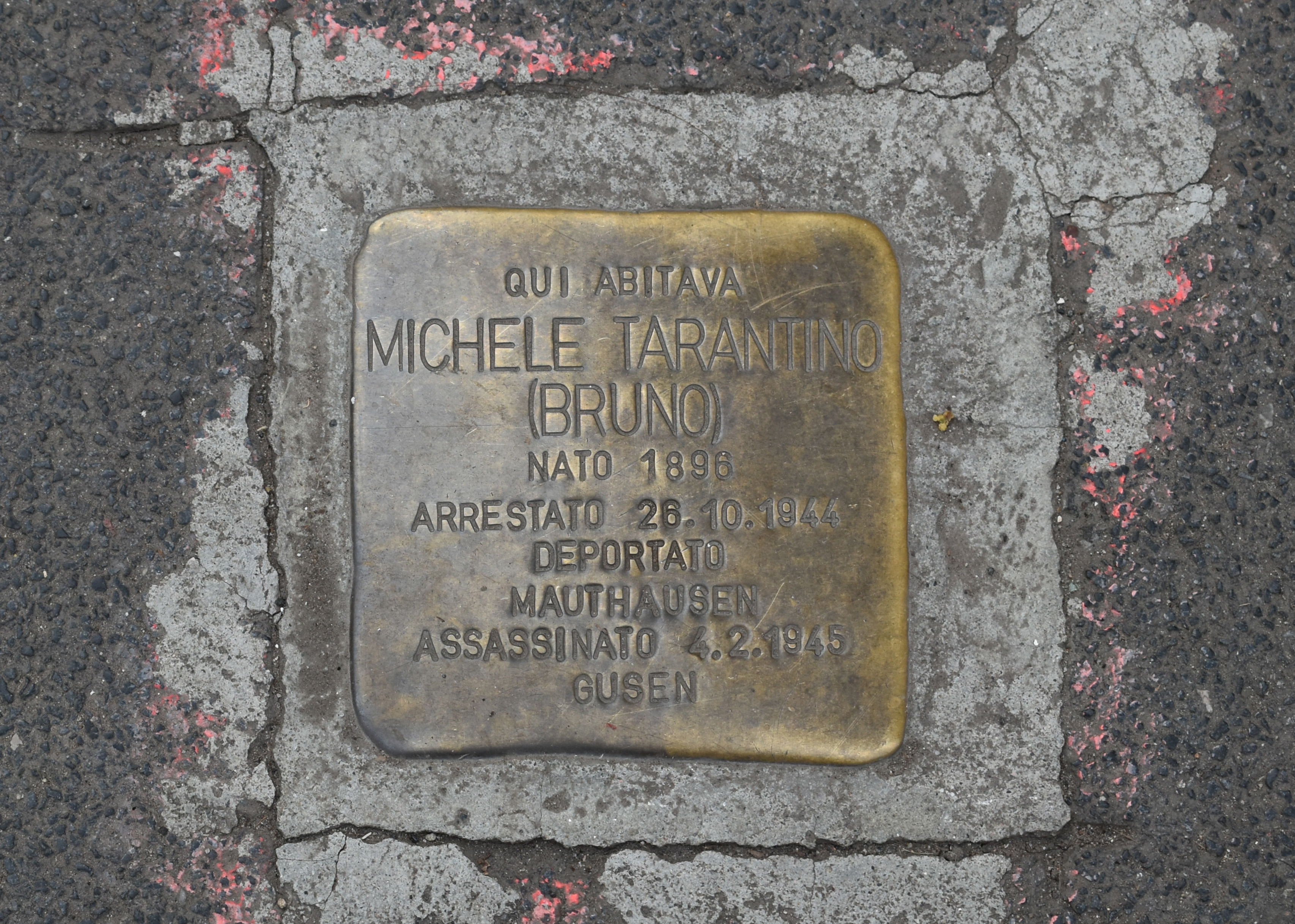
There are two further Stolpersteine for Franco Rovida and Piero Sonnino in that direction, but I had seen those before and needed to head back in the other direction
Back on Viale Campania
Raffaele Gilardino, viale Piceno,33
Retrace your route back to viale Campania - or starting from there if you did not do the extension, head up on the left hand side of the road. After about 10 minutes, you see the Hotel Dateo , where there is a Stolperstein for Raffaele Gilardino. The building is obviously a post war reconstruction.
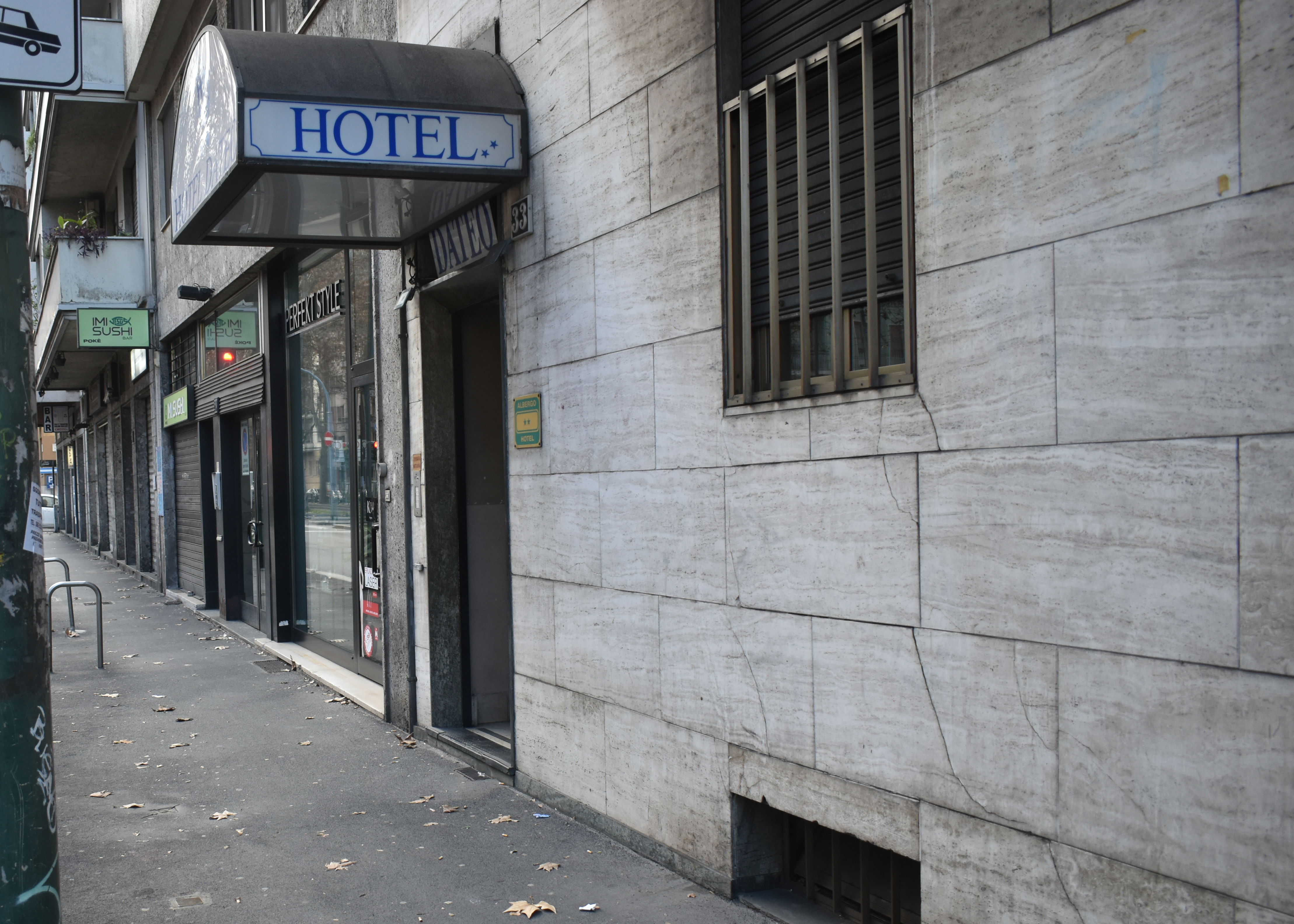
Raffaele Gilardino ( Roma, 21 April 1917). His family arrived in 1932 and established themselves in viale Piceno, 33. He married Ketti Mariani in 1943. Following the allied bombing , the property was damaged and the family fled to Oleggio , where the a son Diego was born. , Raffaele was a lawyer and confirmed liberal of anti-Fascist inclination. After ’8 September he entered an underground resistance group headed by the lawyer, Luciano Elmo. Raffaele was involved in procuring replenishments of arms and equipment for partisan groups in Piemonte and for organising sabotage .He was arrested on 2 August 1944 in a round up based on information from a tout, at Elmo’s legal offices in Viale Regina Margherita, 38 . From San Vittore, he was sent to Bolzano, to Dachau , Buchenwald, and Ohrdruf where he died on 1 February 1945.

Staying on the same side of the road, you have to keep going north for about 10 minutes, turn left into via Carlo Goldoni and then take the second right into via Castel Morrone. there are two memorials on this road
Vincenzo Aulisio, via Castel Morrone, 4

Vincenzo Maria Romano Aulisio ( Ascoli Satriano (FG) il 21 March 1904 ) . Vincenzo started his studies in a seminary , but then went to the Liceo Ginnasio in Caserta. One of his mathematics professors was Ettore Croce, socialist, trade unionist and revolutionary, who had been elected as a Parliamentary deputy in 1919 for the socialist party. In 1921, Vincenzo took part in the electoral campaign. He followed the Professor to Rome, where he married Bianca Maria in 1926.They had three children. From 1927 Vincenzo was entered into the Casellario Politico Centrale as a communist. Vincenzo was forced into exile in France and Belgium. Vincenzo’s health was poor and he returned to Italy, under the supervision of his father and the constant surveillance of the OVRA: After a stay in the South, latterly in Bari where he entered into contact with anti-Fascist groups . At the end of the 1930s, he transferred to Milan, where gained work with the publishing house Mondadori. He joined the armed struggle on 28 September 1943 and commanded a detachment of the 140° Brigata Garibaldi in Val Brembana. At the end of December 1943 he was arrested and locked up in San Vittore. On 27 April 1944 he was transferred to Fossoli and on 21 June1944 with Transport 53 to Mauthausen, he died at the sub-camp of St. Valentin on 21 March 1945.

Guido Levi and Olga Levi. via Castel Morrone
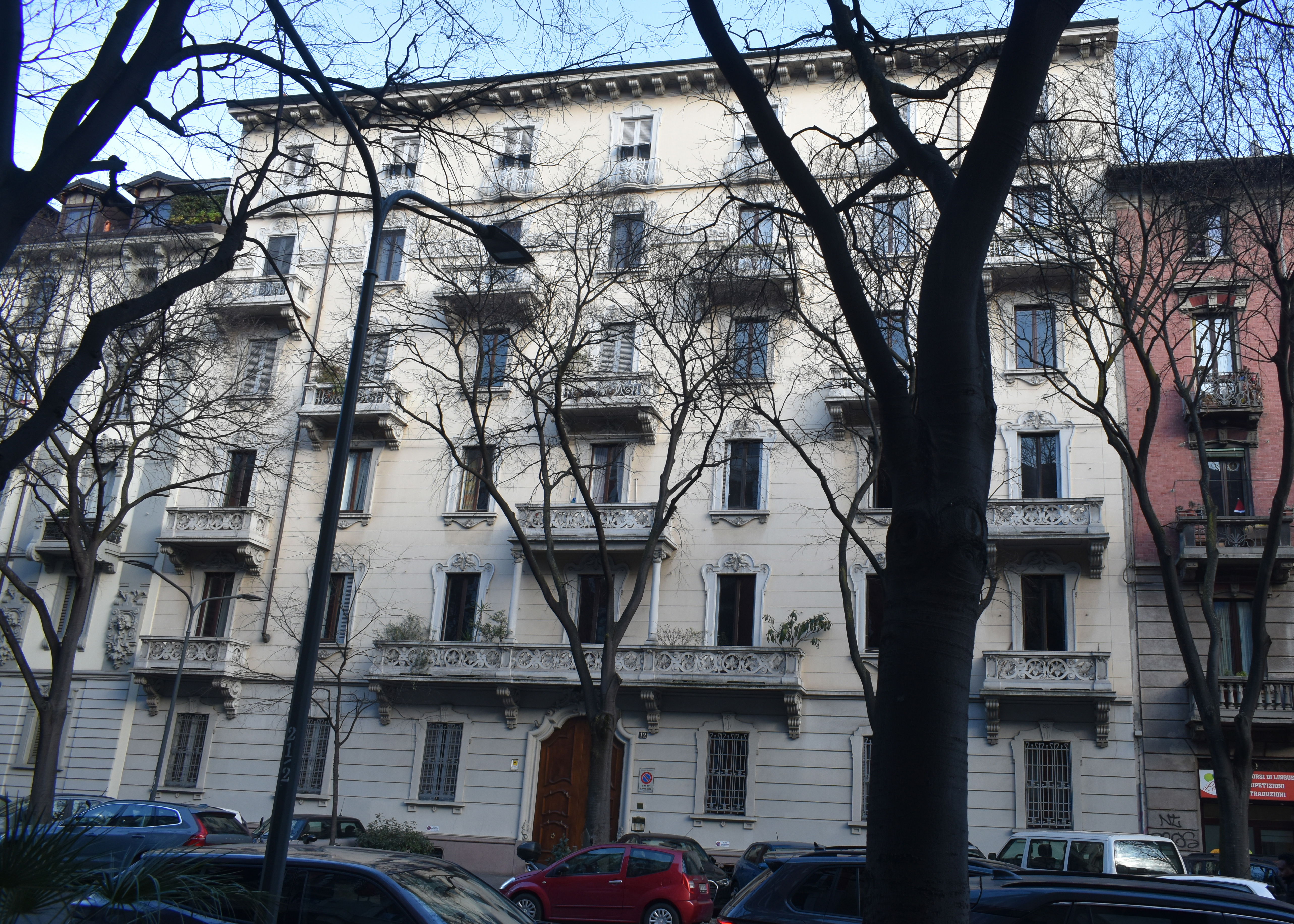

Guido Levi (Ancona il 9 September 1882 ) and Olga Luigia Ascoli Levi ( Livorno il 7 November 1877) The couple were married in Florence and then moved to Milan in 1908, where Guido was a merchant. In 1942 they fled to Como. After 8 September, Olga Luigia turned down the idea of fleeing to nearby Switzerland. Believing that because of their age nothing would happen to them. On 23 September they were arrested in Como., taken back to San Vittore and deported to Auschwitz from Milan Central Station on transport 12 on 6 December1943. They were murdered on arrival.
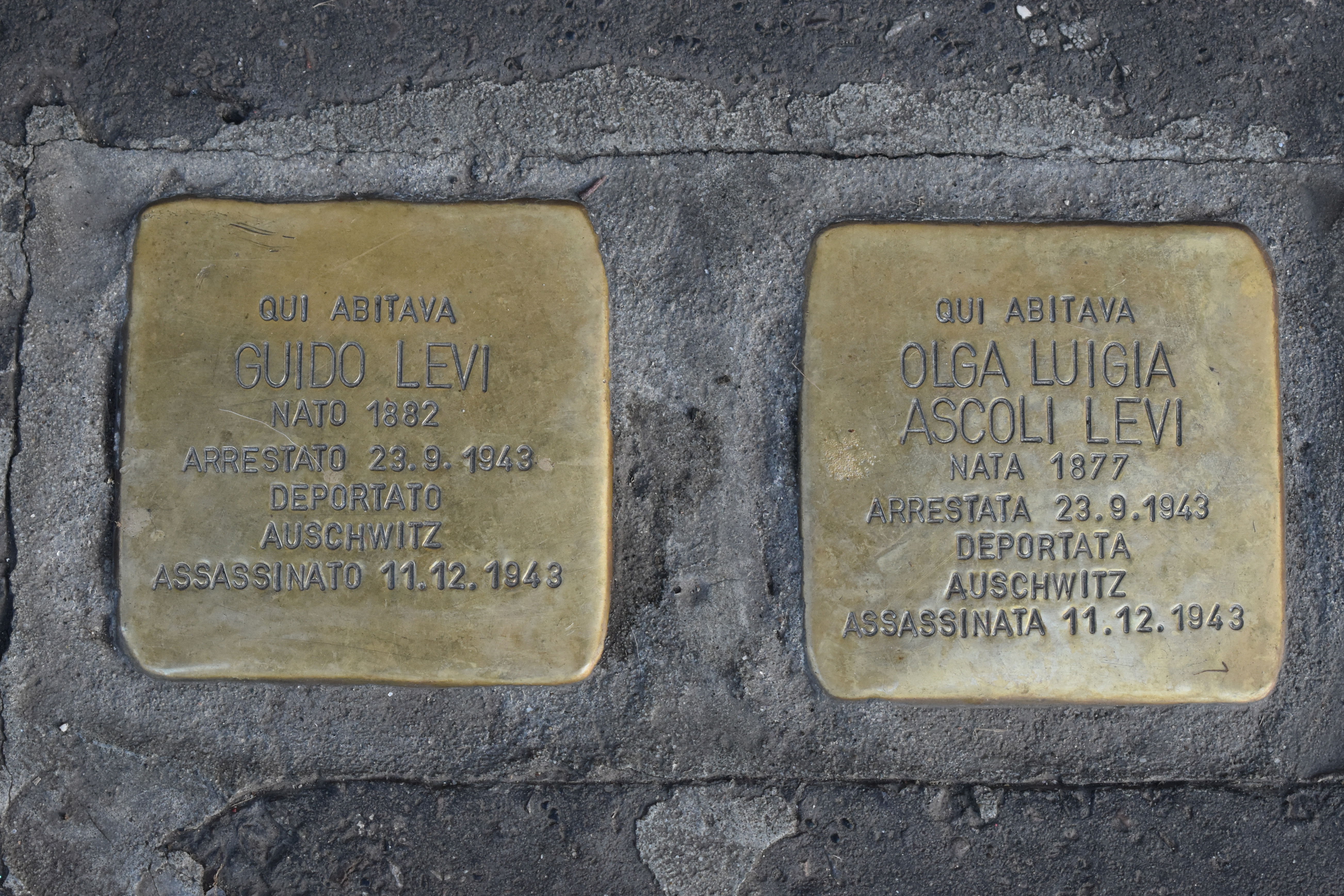
Iginia Fiorentino, via Plinio 70


Iginia Fiorentino ( Livorno il 17 April 1872), the cousin of Samuele Fiorentino, had a diploma in design and taught in Milan at the Scuola normale femminile Carlo Tenca and then the Scuola di Avviamento Professionale Giulio Romano. Following the Racial Laws, shew was no longer allowed to teach. She lived with her sister Emilia, also a teacher at Via Plinio 70. In 1940, they retreated to cousin Samuele’s villa at Porto Ceresio. In November 1943, the Germans began to round up even the over seventies and arrested both sister. Emilia was sent to hospital in Varese with a broken leg and managed to hide until the end of the war, Iginia was transported to Auschwitz on Transport 24 on 30 January 1944 and was murdered on arrival.

Beatrice Ottolenghi, via Francesco Hayez

Beatrice lived with mother and sister in via Hayez 19. Originally the family were from Venice, but they had moved to Milan to get way from the frontline in the first world War and to join their son Achille who was working as a lawyer there. .Beatrice looked after her elderly mother and her sister Maria worked as a journalist. The mother died in 1942 and the house was damaged in the Allied Bombing, so the family fled to the countryside renting a house near Erba. Meanwhile the family property was confiscated., Brother . Achille managed to get to Switzerland and Maria saved herself fleeing to Rome. Beatrice tried to cross into Switzerland in through Val d’Intelvi but was stopped at the frontier on 20 January 1944 by Italian border guards. She was imprisoned at Como , transferred to San Vittore, then Fossoli and was deported with Transport 37”, on 5 April 1944 to Auschwitz-Birkenau . She died some time in December 1944.

mario Luzzatto

Mario Luzzatto (Mira (VE) , 11 August 1912) After completing his studies, Mario lived for a while in France and then moved to Milan where he ran a small metal working business. He married Adele Pogutz, they had no children. Mario was arrested in Milano on 21 April 1944 and deported to Auschwitz on 2 August 1944 and was murdered on 16 September 1944.

Enzo Capitano
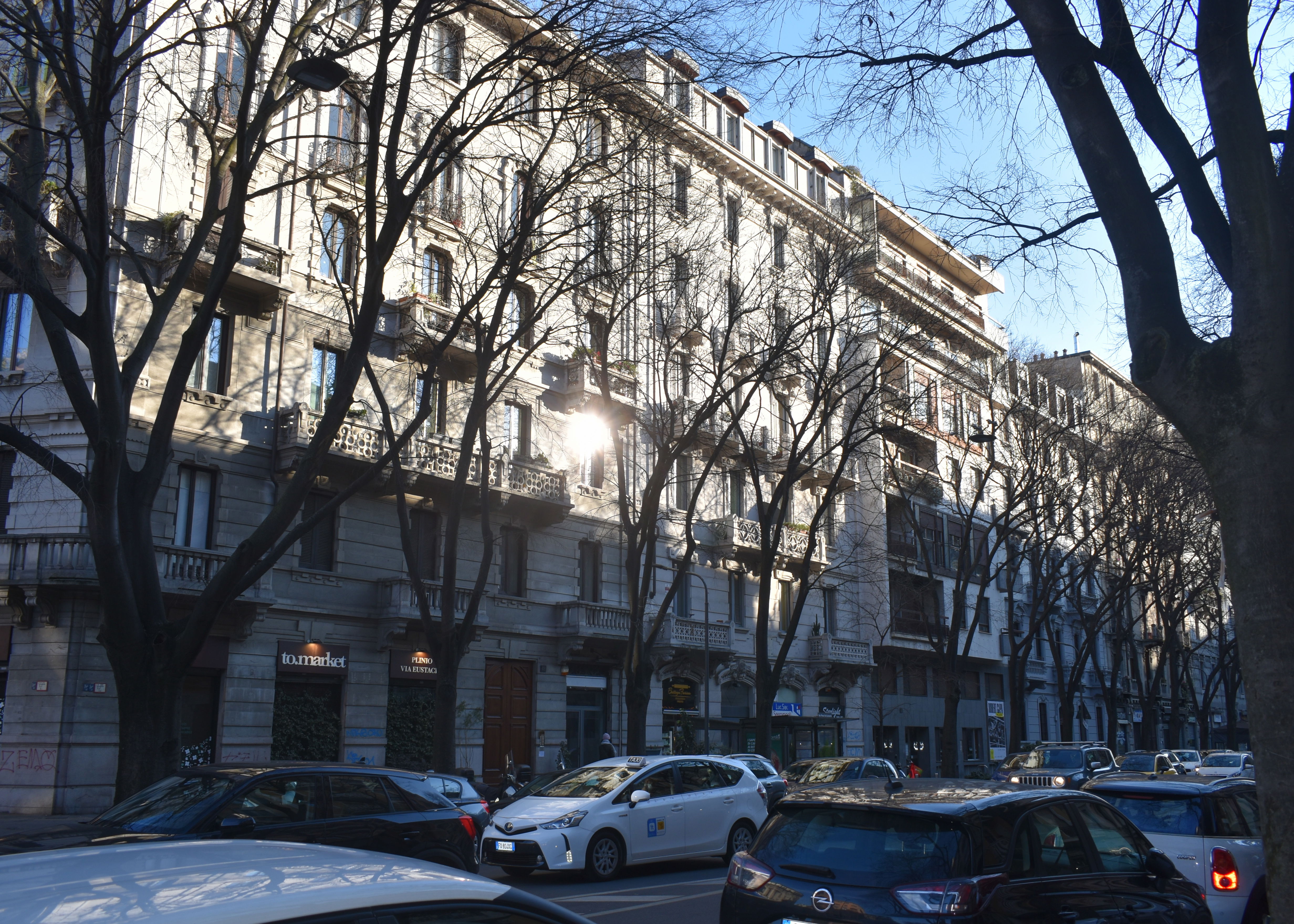
Enzo Capitano ( Milano.26 January 1927), In he was a pupil at the Liceo Classico Carducci and joined the Fronte della Gioventù founded by Eugenio Curiel, which after ’8 September, with the of the teacher Quintino Di Vona opposed the RSI and the Nazi occupation. Professor Di Vona was murdered on 7 September del 1944 a Inzago by Fascist militia. In January ’44 Enzo Capitano had been picked up at school with other classmates by the thugs of the Brigata Muti and subject to a roughing up and violent interrogation, before being released. Following the murder of Di Vona, he intensified his antifascist activity and was arrested again on 22 December 1944 , following the usual tip off by a tout. He was taken to a San Vittore and handed over to the SS.
On 16 January 1945 he was sent to Bolzano, while the train passed through Brescia, he was able to throw a message out of the train window which miraculously arrived back with his family. It read : “ The good soul who finds this note would give great pleasure to a deportee and send it to the Capitano family via Stradella 13, Milano. Dear dad, dear mum, dear brothers and sisters , too bad I am being sent to a concentration camp” A few days later he was loaded onto a train to Flossenburg, before reaching the Brenner Pass, he and two other detainees managed to jump off the train and take refuge in a nearby barn, unfortunately they were betrayed to the Germans who sent them back to Bolzano. On 1 February 1945 he was sent to Mauthausen. He was in the camp hospital when the Americans liberated the camp. It was however too late to save him and he died on 9 May 1945. He was 18 years old.
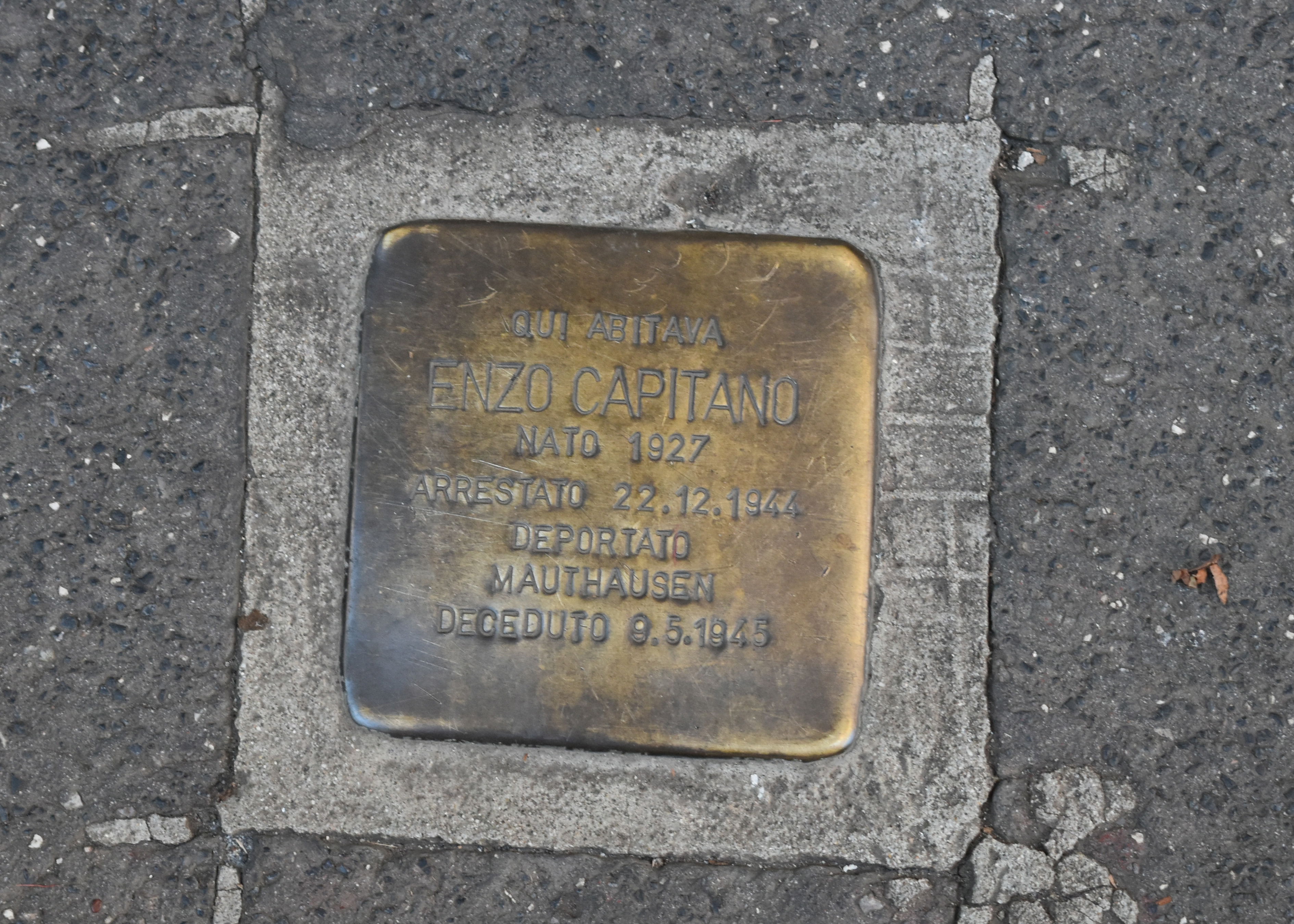
Angelo Fabello
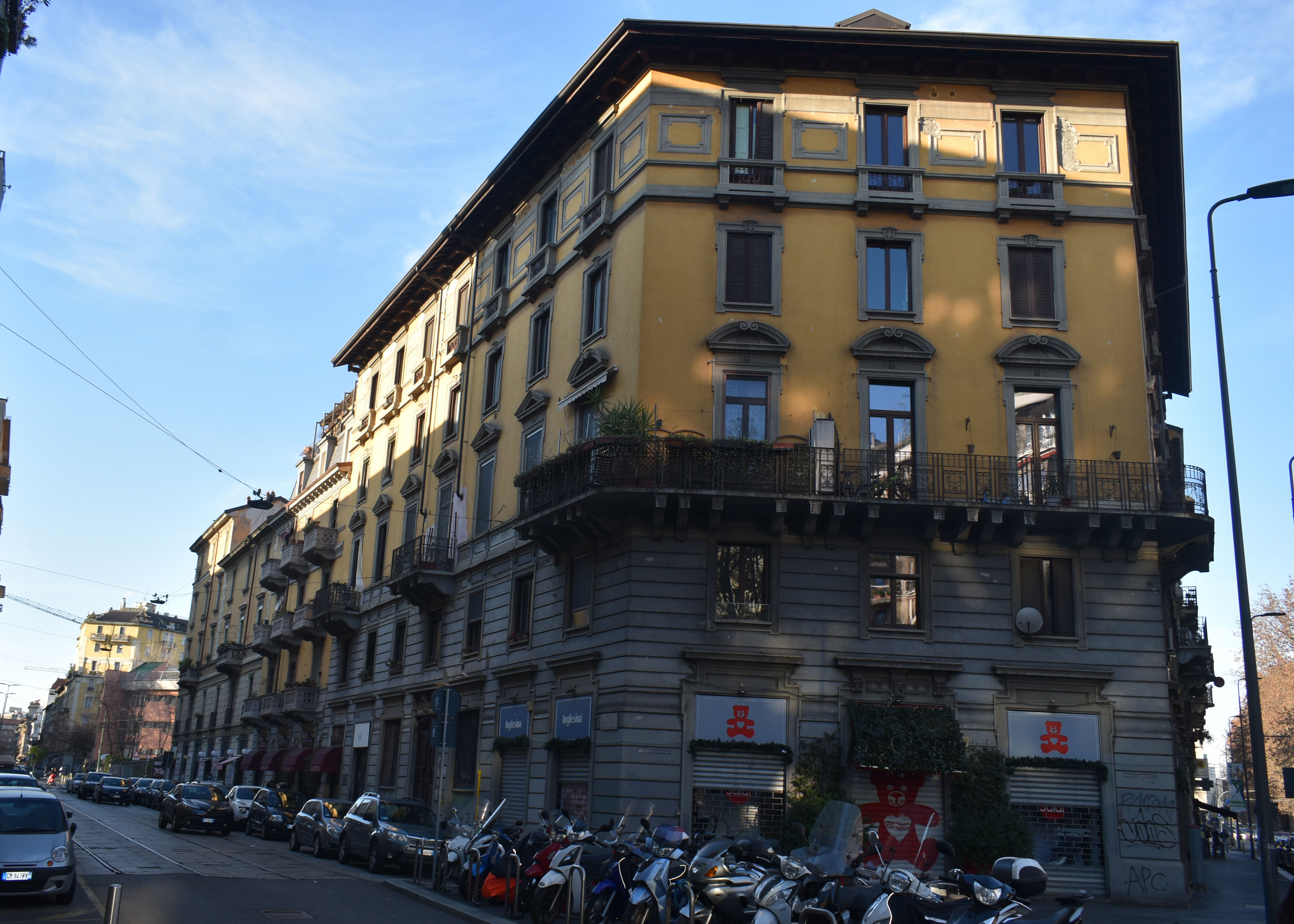

Angelo Fabello ( Udine, 26 August 1897) Following the first world War, his family transferred to Milan, where Angelo worked as a tailor. In 1939, he left the family in Milan and returned to Udine. After 8 September he joined the partisan brigata Osoppo which operated in Friuli – Venezia Giulia: and in February 1945 he was arrested at home, following a betrayal. He was deported to Mauthausen on 7 February 1945 and died in the sub/camp of Revier on 24 March 1945.


A cattle wagon at Binario 21. Around 50 people would be forced into each wagon